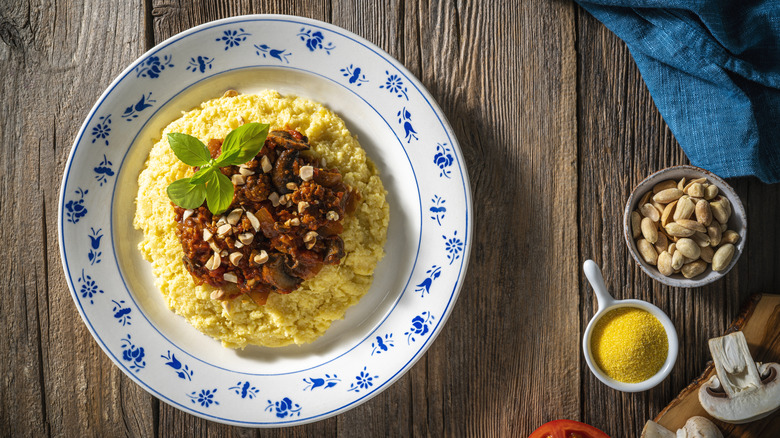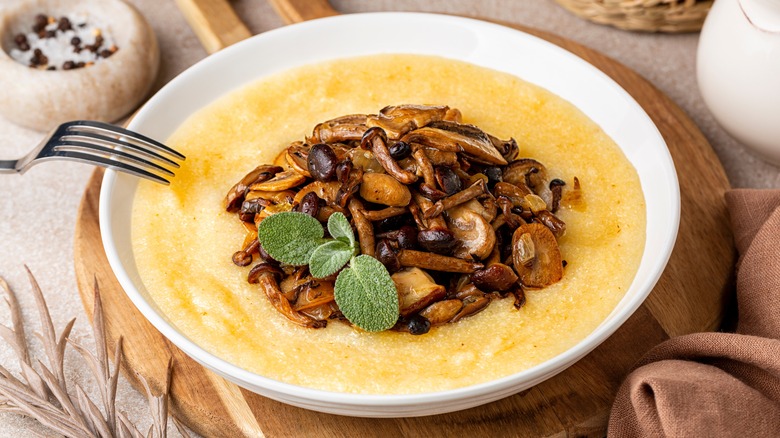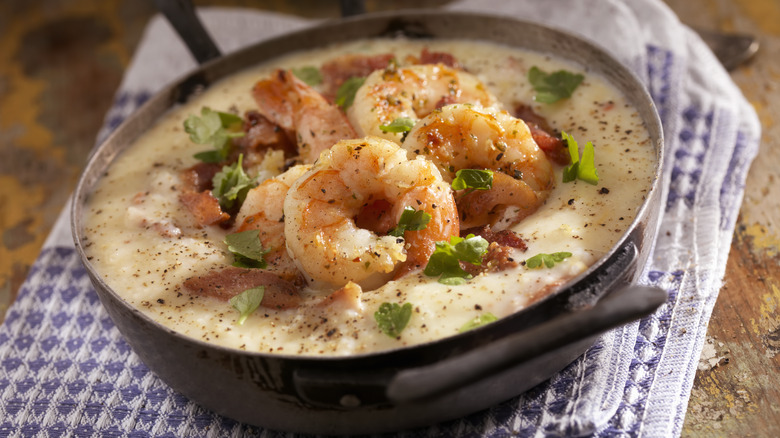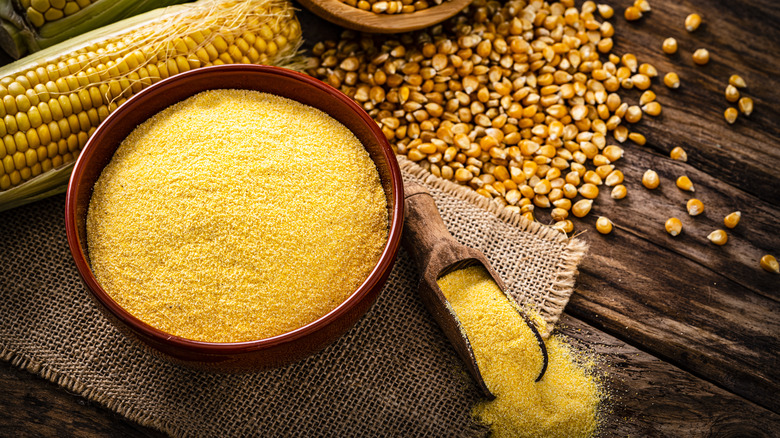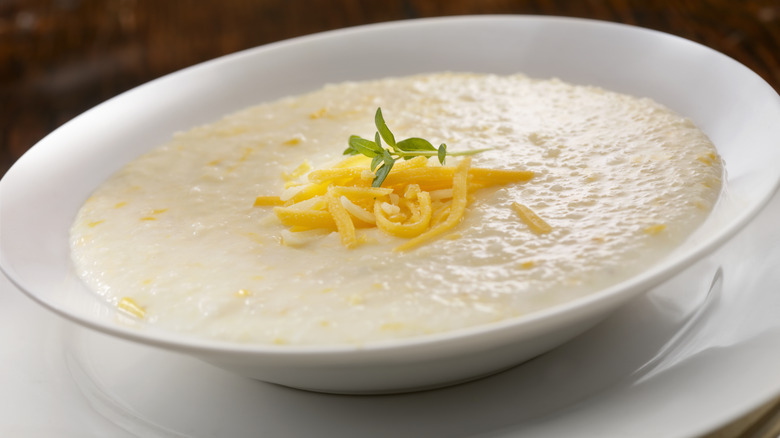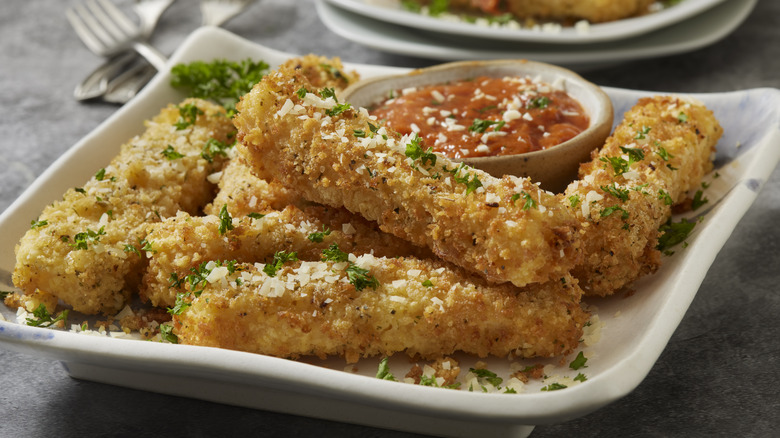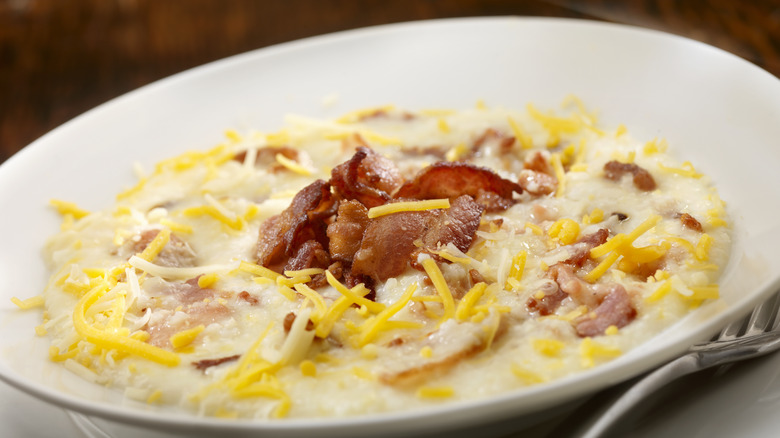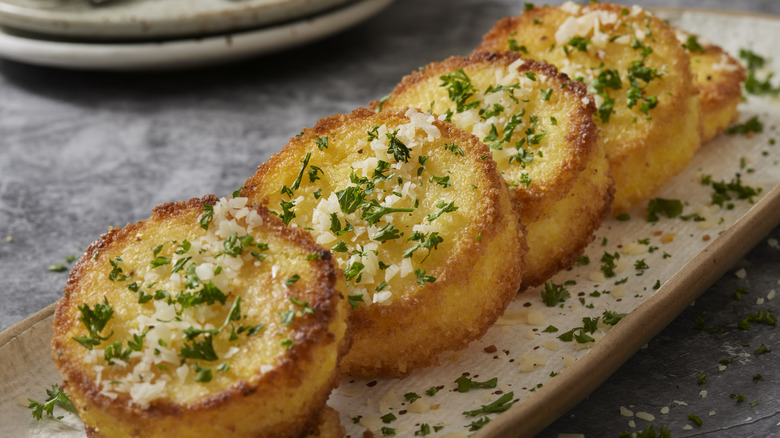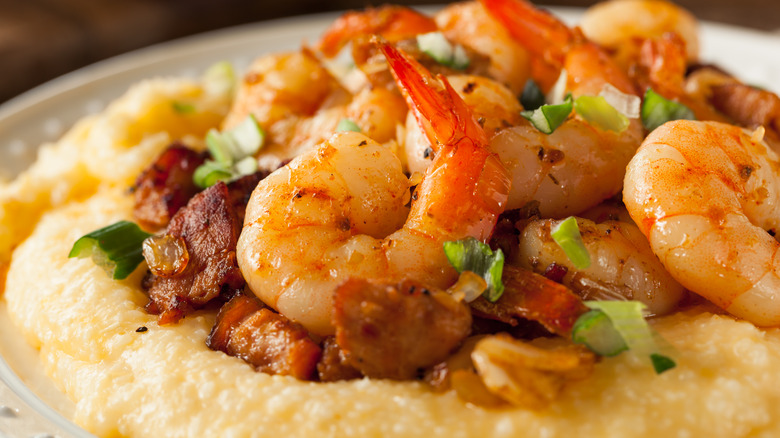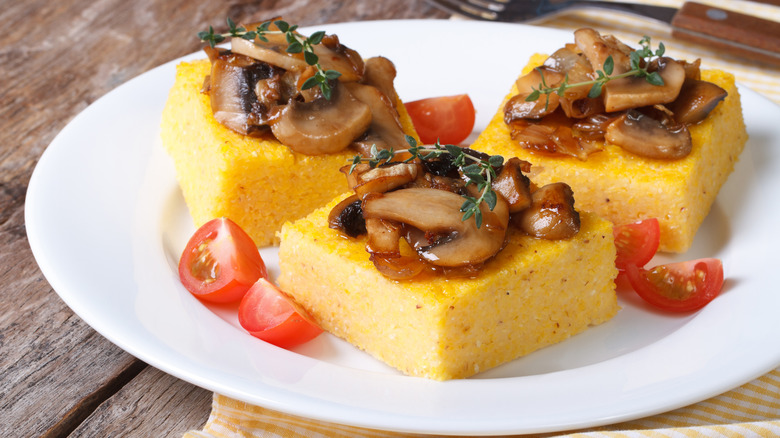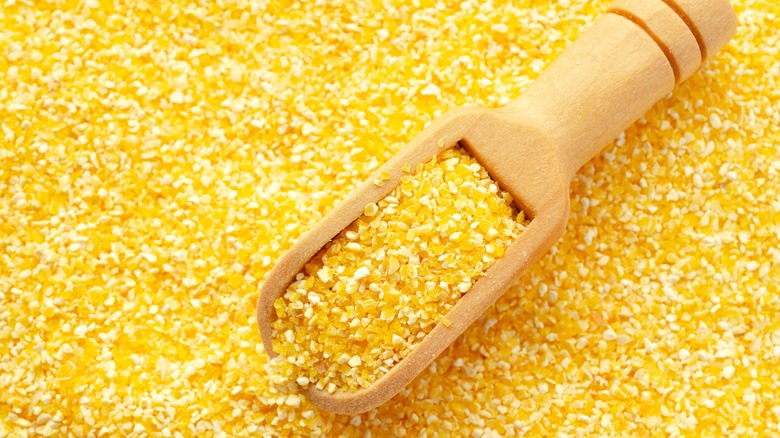Polenta Vs Grits: The Similarities And Differences Explained
On paper, polenta and grits might seem very similar. They are both made from ground corn, and they are both a creamy, puree-like dish (in most cases). They are both yellowish in color, and they can be topped with savory favorites like shrimp or sausage. However, if you were to see a bowl of grits next to a plate of polenta, you would clearly be able to tell that they are two completely different things.
Polenta hails from Northern Italy, where it has been consumed since ancient times. Grits are a newer addition to the world's cuisine and were introduced by Native Americans in the 1600s. While both do have similar methods of preparation, they are made from different types of corn and have different consistencies, tastes, and colors. Luckily, you have a writer who can help you to understand these differences, as well as their commonalities.
Growing up in the American South (where grits are a popular dish) and later moving to Northern Italy (where polenta is popular), I have been fortunate enough to have had firsthand experience eating both. To write this, I also consulted authoritative sources in the culinary and educational spheres to delve deeper into the history of these dishes — and to ensure all facts and statements are accurate — so that I can give you a clear look at both polenta and grits.
What is polenta?
Polenta is, to put it simply, boiled cornmeal. While that may not sound very appealing to you at first, think about this: this is an Italian dish. Have you ever known Italians to cook something bland or tasteless? I didn't think so!
Polenta is made from flint corn, which is responsible for polenta's bright, sunny, yellow hue. We can trace its origins back to ancient times — we're talking 2000 to 1000 B.C. But it wasn't always made out of corn. At first, it was made from different types of grains, like buckwheat or barley, or flours made with beans or chestnuts.
This creamy concoction was a common food during the Roman Empire, where it was often made from buckwheat, water, salt, and just a touch of milk mixed in a terracotta pot. After Christopher Columbus brought corn to Europe in the 1500s, people started using that to make polenta instead and this version has stood the test of time.
Back then, it was a dish commonly served among peasants, as it was easy and cheap to make, but today, it can be enjoyed by all. It remains more popular in Northern Italy than Southern Italy, though, as the former produces more corn crops.
What are grits?
Like polenta, grits are made from ground corn. When boiled with water, they are a popular, porridge-style dish in the American South. They are often made from hominy, a type of dried sweet corn that has been soaked in a special solution that makes the kernels swell to a larger size and a different consistency. They are then ground up and boiled in salted water, after which other things like butter are added for flavor.
Grits originated in America and were passed down from the Muskogee Native American tribe in the 1600s. The tribe members often made this dish by coarsely grinding up hominy in stone mills, something that they eventually shared with European settlers in Virginia and what would eventually become the other southern states. At that time, hominy was treated like money and was often exchanged for other goods. When the settlers learned this system and began to accept hominy as a form of currency as well, they learned the recipe for making grits and passed it down through generations until today. It is still a well-loved dish, especially in the South.
Polenta has more of a yellow color
While some people may be tempted to say that polenta and grits are "basically the same thing" because they are both made from ground corn, there is one very important difference between them. Yes, they are indeed both made from corn, but they are made from different types of corn. This is something that completely changes their taste, consistency, and color.
Polenta is made from yellow flint corn, so it is a bright yellow color similar to that of a sunny egg yolk. Grits, on the other hand, are made from white dent corn or hominy, so they are a much lighter, paler color. Dent corn is a softer, sweeter type of corn, so this often means that grits, while still being a savory dish, may tend more toward the sweet side of the scale, while polenta is firmer and less sweet. This difference in corn types is the biggest dissimilarity between the two dishes. It just goes to show you how much food can change just by altering one seemingly small detail.
Both are naturally gluten-free
One thing that polenta and grits have in common is that they can be eaten by those with a gluten intolerance. Since they are made with corn, not with wheat like other porridge dishes such as Cream of Wheat, they do not naturally contain any gluten. This makes them a great option for those who cannot tolerate gluten, but are still looking for a hearty, boiled grain meal.
However, it is important to note that if you buy a box of quick-cooking grits or polenta from the store, you should still check the ingredients list to ensure that nothing else has been added that may contain gluten. It is also recommended to make sure that the polenta or grits were not manufactured in a facility in which the machinery was used to grind other types of grains, as this could lead to unintentional cross-contamination. Being mindful of what you add to your dish or use as a topping is a must as well, as things like breaded shrimp may be coated with flour, which means that they are not gluten-free.
There are four different types of grits
Where your standard polenta usually just comes in one form (except when it's baked or fried), there are four main types of grits. The first of these is stone-ground grits. As their name clearly states, these are grits that have been ground in an old-fashioned mill using two large, heavy stones. These have a richer, cornier flavor and a thicker, coarser texture because they use the full kernel of corn and are not ground into as small pieces as the other types of grits.
Regular and quick grits are ground up more finely. Since they are composed of smaller pieces of corn, they cook in around ten minutes, as opposed to stone-ground grits, which need to cook for hours. Instant grits are a third different type and are the finest-ground of the four. They aren't as full-flavored as the other types, but they can cook very quickly.
Finally, we have hominy grits, which are made from corn kernels that have been soaked in lye or lime. Before they are ground, the exterior layer of the corn is removed, giving the finished product a more coarse, puffy texture than its stone-ground counterpart.
Both polenta and grits can be baked or fried
When one thinks of polenta, one usually thinks of a bright yellow dish resembling a mealier version of mashed potatoes. When they think of grits, they think of something like porridge: a creamy, moist, mushy dish. But this is not all there is to these two cornmeal favorites.
Both polenta and grits can be baked or fried and used to make other dishes. In Italy, for example, polenta is often served at restaurants in a deep-fried form that you can eat with cheese or a tomato-based or meat-based sauce. You can also make "grit cakes," which are deep-fried patties composed of grits and topped with your choice of syrup, cheese, or your choice of other sweet or savory accompaniments. Grits can be baked into a solid casserole-type dish as well, most often in the company of cheese and eggs.
Typically, polenta lends itself more easily to baking and frying, since it already has a denser, firmer texture in its original form. Grits, on the other hand, can still be used in this manner, but you may find that the baked grits don't get as solid as you may like. Another notable difference is that polenta is always paired with savory things like cheese or sauce, while baked or fried grits can also be eaten with sweet additions.
Grits are creamier
Another difference you will notice by looking at and/or tasting polenta and grits side by side is that they have a different consistency. Grits are creamier and more moist, while polenta is drier and firmer. Grits are usually served in a bowl, like a soup or cereal, but polenta is served on a plate like mashed potatoes because it holds its shape better. But if they are both made from corn, why this disparity?
Like with their color, this is another difference that can be attributed to the different types of corn that were used to make them. Grits are made from dent corn, which is not only sweeter, but starchier. This contributes to its creamy consistency, something that the flint corn used to make polenta doesn't do. Depending on the type of grits you are making, the coarseness of the ground grain could be the same in both dishes, but this difference in starch levels completely changes the texture regardless. After the color, this is the best way to tell them apart.
Polenta is not a breakfast food
In the Southern United States, grits are often eaten as a part of a big, hearty Sunday breakfast. They can be served right alongside the biscuits and gravy or the sausage and bacon, or they can just be enjoyed with a big pat of butter on top. But if you tried to eat polenta for breakfast in Italy, the people around you would think you had lost your mind — or just your watch.
While grits are most often a savory dish, they are still eaten as a hot breakfast in many places. Polenta, however, is always served as a pasta alternative for lunch, or more rarely dinner.
Perhaps grits owe their popularity at the breakfast table to the fact that their flavor is often pretty plain. Unless you are using stone-ground grits, there is only a light hint of corn here, whereas polenta has a stronger taste to go with its firmer texture. Grits may be more comforting in this respect, as you can eat them as a hot cereal to warm you up inside on a cold morning, and you can even make them sweet by adding syrup, if you prefer your breakfast on the sweet side instead of the salty one.
Grits have more calories
It is difficult to compare grits and polenta in terms of nutrition, because they can be made differently and with different additions, but there are some notable differences that we can see from the base nutritional facts. Grits, for instance, are a higher-calorie food, with 71 calories per 100 grams. Polenta, on the other hand, has 64 calories per 100 grams. Polenta also contains no sugar, while grits have 0.12 grams per 100-gram portion. While that is still a very low amount of sugar, it can most likely be attributed to the sweeter corn grits are made from.
When it comes to fat, both grits and polenta have around 0.4 grams per 100 grams. They also share an identical 0.8 grams of fiber per 100-gram serving. They are close in carbohydrate counts too, as grits have 14.8 grams of carbs and polenta has 13.6 grams.
Looking at calcium, polenta wins the race here, with 16 milligrams per serving as opposed to grits' one single milligram. Polenta has more sodium too, with 216 milligrams in comparison to the 2 milligrams in grits.
Both can be used in many savory dishes
While there may be some exceptions (we're looking at you, orange polenta cake), both grits and polenta are normally used in savory dishes. They are rarely served alone because they can be a little on the bland side, which gives us some nice, inventive options like polenta with ragù, polenta with lamb, fried polenta with prosciutto, polenta tarts with sausage, and polenta bruschetta. You can also make stuffing with a polenta base instead of bread, or bread chicken with it to make polenta-crusted chicken legs and thighs.
With grits, you can go with the world-famous shrimp and grits, or you can think outside the box with things like a cheddar, bacon, and grits quiche or a grits casserole with vegetables, eggs, or various breakfast meats like ham and sausage. You can also try making a grits soufflé, fish and grits, or a grits frittata. There are even recipes for grits with pulled pork and either cheese or barbecue sauce, giving you lots of options.
Or, if you'd like, you can eat either dish on its own with just some salt and butter. It's all up to you and your palate!
Methodology
To get a full and objective look at grits and polenta, I used trusted sources in the culinary world to find out more about both dishes and also relied on my own experiences eating them.
